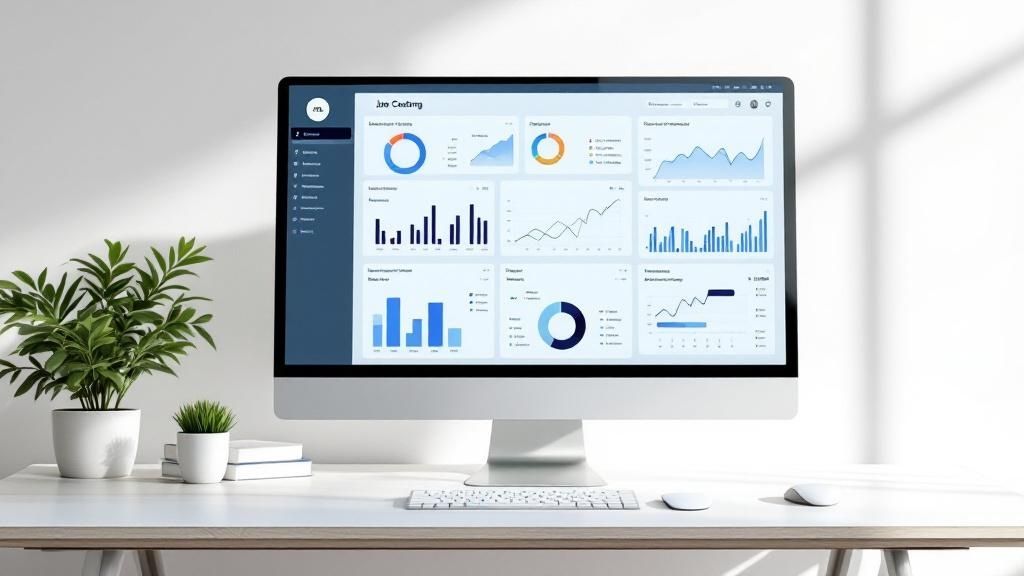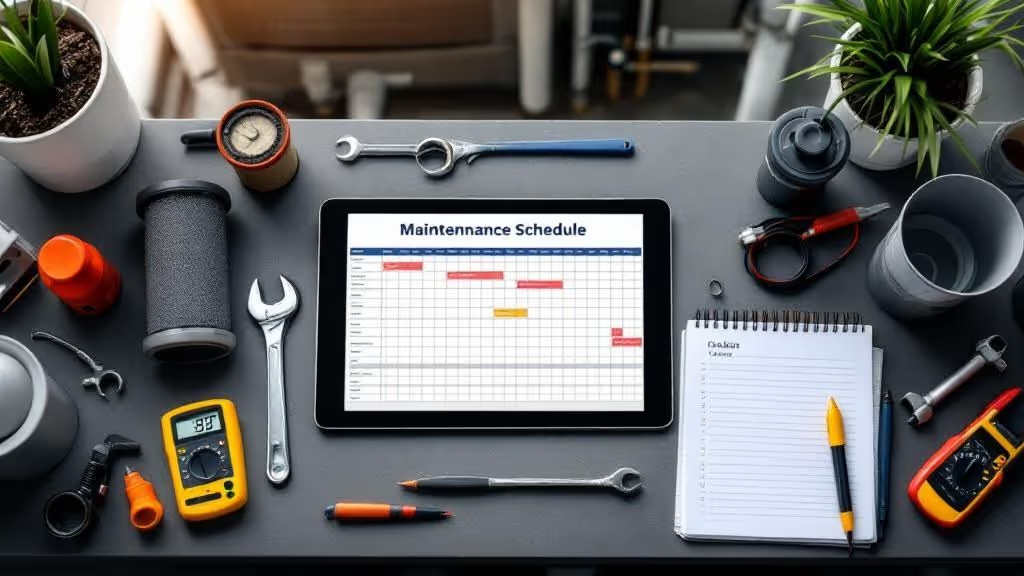Why Most Businesses Get Job Costing Completely Wrong
Let’s be real for a moment: many businesses, especially those in the trades, are essentially flying blind when it comes to their true project costs. I’ve had candid conversations with countless project managers who admit their pricing is often based more on gut feeling and a quick look at past invoices than on a precise understanding of their expenses. This isn't because they aren't trying; it's because the old-school ways of tracking costs are fundamentally broken for the dynamic nature of field service work.
Getting accurate job costing right means looking far beyond just adding up materials and logged labor hours. The real profit-killers are the hidden costs that silently add up, going completely unnoticed until you’re looking at your bank account wondering where the money went.
The Psychology of "Good Enough" Costing
One of the biggest hurdles isn't a spreadsheet formula or a new piece of software; it's a mental one. Teams get stuck in a "this is how we've always done it" mindset. Setting up a proper system feels like a massive project, so they stick with what they know, even if it's costing them. This resistance often comes from a fear of what the real numbers might uncover. It’s much more comfortable to assume a job was profitable than to face the hard evidence that you actually lost money on it.
This "good enough" approach creates a dangerous cycle. You underprice a job, your margins get squeezed, and you try to make up for it on the next one, still working without solid data. You end up relying on your gut, which is a recipe for inconsistent profits and, eventually, burnout.
Where the Real Costs Are Hiding
The most common mistake I see is businesses focusing only on the obvious big-ticket items. They will meticulously track something like a new HVAC unit but completely ignore the smaller, yet significant, expenses that eat away at their profit. These "cost leaks" are everywhere if you know where to look:
- Scope Creep: Think about those small, "no big deal" client requests that add 15-20 minutes here and there. Across an entire project, this can easily add up to hours of unpaid labor.
- Indirect Materials: Consumables like sealant, fasteners, or protective gear might seem minor on their own. But when you multiply that by dozens of jobs, their total cost becomes substantial.
- Return Trips: A technician forgets a specific tool or a part wasn't on the truck, forcing a second trip. That’s wasted fuel, lost productivity for that tech, and a schedule that's now off-track.
The widespread nature of this problem is fueling massive market growth. The job costing software market was valued at USD 7.49 billion in 2023 and is projected to skyrocket to USD 18.17 billion by 2030. This boom shows a broader industry awakening to the critical need for better tools. You can explore more about these market trends and their drivers. Overlooking these small details is like trying to fill a bucket with a hole in it—you can keep pouring in revenue, but you'll never actually get ahead.
Building Your Foundation Without Overcomplicating Everything
Before you get lost in fancy software or tangled spreadsheets, let's talk about the single most important part of accurate job costing: creating a solid, simple foundation. So many businesses I’ve seen get stuck in "analysis paralysis," trying to build a system that tracks every last penny from the get-go. This almost always ends in a system so complex that nobody uses it, wasting months of effort. The goal here isn't perfection; it's clarity and consistency.
You have to start by figuring out which cost categories actually move the needle for your specific business. A marketing agency's critical costs are worlds away from a construction crew's. Focus on what truly impacts your profitability.
Define Your Core Cost Categories
Forget generic templates. Think about the real-world flow of your work. For a landscaping business, for example, you might break costs down into a few essential buckets:
- Labor: This isn't just the hourly wage. It has to include payroll taxes, workers' comp, and a slice of benefits.
- Materials - Standard: This is the everyday stuff—mulch, soil, common plants—that you use on most jobs.
- Materials - Job-Specific: This is for the big-ticket or special-order items, like a custom-built pergola or a rare tree variety for a specific client.
- Equipment & Vehicle Costs: A calculated rate to cover fuel, mower maintenance, insurance, and wear and tear.
- Overhead: A simple percentage added to each job to cover office rent, admin salaries, and other costs of keeping the lights on.
To give you a clearer idea of how this varies, here’s a look at what different industries should be tracking.
Essential Job Costing Categories by Industry
Comparison of critical cost categories across different industries with specific examples
This table shows that while the "what" changes, the "why" stays the same: you need to see where every dollar is going to protect your margins.
This kind of visibility is what separates struggling businesses from thriving ones. When you see your costs clearly, you can manage them effectively. The upward trend here isn't just a graphic; it represents the direct link between detailed cost tracking and a healthier bottom line.
The upward trend here isn't just a graphic; it represents the direct link between detailed cost tracking and a healthier bottom line.
Make Data Collection Effortless
Once you’ve defined your categories, the next hurdle is getting the data without creating a bureaucratic headache. This is where most job costing systems fall apart. If tracking expenses feels like a chore for your field team, they'll find shortcuts or just won't do it. The easier you make it to log time or a purchase, the better your data will be.
This is where you can lean on simple, modern tools. For instance, a technician in the field using a tool like Nora can snap a photo of a receipt or send a quick voice memo about a material purchase through WhatsApp. That data is then automatically categorized and assigned to the right job file. It completely removes the friction of old-school methods. Instead of stuffing receipts in a glove box to be dealt with weeks later, the information is captured accurately in the moment.
Always remember this: a simple system that is used consistently is infinitely more valuable than a perfect system that is ignored. Building these easy data-capture habits is the true foundation of a successful job costing strategy, turning scattered information into a powerful tool for your business.
Tracking Labor Costs Without Creating a Bureaucratic Nightmare
Labor is almost always the biggest line item on a project budget, yet it's often the fuzziest number. Trying to pin down these costs for accurate job costing can feel like an impossible choice: either you micromanage your team into oblivion, or you accept vague, unreliable data. The real goal is to find a middle ground—one that respects your team's autonomy while delivering the clarity you need. Instead of building a surveillance state, focus on making time tracking a natural part of the daily workflow.
Think about it from your team's perspective. A busy HVAC technician shouldn’t have to stop a complex repair to fill out a clunky timesheet. A better way is to use smart systems that let them log their arrival and departure from a job site with a simple tap on a mobile app, automatically allocating that time. This shifts the process from tedious manual entry to passive tracking, which removes the administrative headache and makes people far more likely to do it correctly.
Handling the Messy Reality of Labor Costs
A simple hourly wage is just the tip of the iceberg. To get a truly accurate job cost, you must account for the fully burdened labor rate. This is the real cost of having an employee on your payroll, and it includes much more than just their wages:
- Payroll taxes (like Social Security and Medicare)
- Workers' compensation insurance
- Health insurance premiums
- Retirement contributions (like a 401k match)
- Paid time off (for vacations and sick days)
If you overlook these "hidden" costs, you could easily understate your labor expenses by 30-40%. That’s enough to turn what looks like a profitable job into a surprising loss. To keep this from becoming a major burden, using efficient payroll management systems is a game-changer for capturing every employee-related expense accurately.
Accounting for Indirect and Non-Billable Time
Not every minute of an employee's day is spent on a billable task. What about the time they spend driving between job sites, picking up materials from a supplier, or sitting in a weekly team meeting? This indirect labor is a very real cost of doing business, and it has to be allocated somewhere.
A common and practical approach is to build a calculated percentage for these activities into your overhead costs, which you then apply to every job. This ensures all that essential, non-billable time is covered without forcing your team to track every single minute. This is especially important as compensation keeps climbing. For instance, data from the U.S. Bureau of Labor Statistics showed that compensation costs for civilian workers recently jumped by 3.6% in a year. You can see the full breakdown of these employment cost trends to understand why this matters. By building these realities into your system, you get a number that reflects the real world, not an idealized version of it.
Material and Equipment Costs That Reflect the Real World
 After getting a handle on labor, the next place job costs tend to get fuzzy is with materials and equipment. If you're just adding up purchase receipts for a project, you're missing a huge piece of the puzzle. For accurate job costing, you have to look at the entire journey of these physical assets and account for all the hidden expenses that slowly eat away at your profits.
After getting a handle on labor, the next place job costs tend to get fuzzy is with materials and equipment. If you're just adding up purchase receipts for a project, you're missing a huge piece of the puzzle. For accurate job costing, you have to look at the entire journey of these physical assets and account for all the hidden expenses that slowly eat away at your profits.
These overlooked costs are lurking everywhere. Think about the material waste from an off-cut, a bit of theft from an unsecured site, or the labor cost just to move inventory from one place to another. Each one might seem small on its own, but they add up to a serious financial drain over time.
Allocating Bulk Purchases and Inventory
Here's a classic headache: managing bulk material purchases. Let's say you get a great deal on a pallet of specialized fasteners. How do you correctly assign the cost of those fasteners to the three different jobs that will use them over the next two months?
A smart way to handle this is to treat your main supply stock like its own mini-distributor. When materials are "checked out" for a job, you assign their cost to that project’s ledger from your central inventory. This keeps things fair, ensuring each job only carries the cost of what it actually used. It prevents one project from taking the full financial hit of a bulk purchase and gives you a much clearer view of each job's real profitability.
Tracking the True Cost of Equipment
Equipment is another area where costs are easily miscalculated. It’s about more than just the sticker price; you have to factor in depreciation, maintenance, fuel, and insurance. One of the most frequently missed expenses is tied to aging machinery. It's not just about the initial purchase; understanding the additional expenses of obsolete commercial kitchen machinery, for example, can drastically change your view of true equipment costs.
To get this right, you can assign an hourly operational rate to each major piece of equipment you own. This rate should be a blend of several factors:
- A fraction of its depreciation value
- Average fuel and maintenance expenses
- Insurance and storage costs
Whenever that equipment is on-site, you simply multiply its operational rate by the hours it was used and add that total to the project's costs. This method makes sure the job is paying its fair share for the tools needed to get it done, bringing you one step closer to true cost visibility.
Creating Systems That Grow With Your Ambitions
What gets you from a five-person crew to a team of fifty is rarely the same system that will take you to one hundred. A job costing process that feels lean and agile today can easily become an administrative mess during a growth spurt. The real secret to sustainable growth isn't just about finding a system that works now; it's about building one that can evolve without forcing you to start from scratch every few years. This means thinking ahead about future challenges and baking flexibility into your processes from day one.
For accurate job costing to scale effectively, you have to find that sweet spot between standardization and customization. Too much rigid structure, and you lose the nimbleness that fueled your early success. Too much customization, and you invite chaos as new people join the team.
Think of a small electrical contractor. In the beginning, they might let technicians buy minor parts as needed and submit receipts. Simple enough. But as they grow to 20 technicians, this casual approach spirals into inconsistent pricing, duplicate purchases, and a mountain of untracked expenses. The answer isn’t to lock down all purchasing, but to create a standard process for common materials while maintaining a clear, documented exception process for unique job needs.
Balancing Standardization and Flexibility
As your business expands, both the complexity of your jobs and the sheer volume of data will grow exponentially. The goal is to design systems that can handle this increase without buckling under the pressure. Here are a couple of practical strategies I've seen work well:
- Tiered Cost Codes: Start with broad cost categories that are easy to manage. But, structure your system so you can add sub-categories later without a major overhaul. For instance, a general "Labor" code might eventually split into "Installation Labor," "Service Labor," and "Training Labor" as your services diversify.
- Template-Based Estimates: For your bread-and-butter jobs, create standardized estimate templates. This makes the quoting process faster and more consistent. Crucially, these templates must be easy to adjust for each client's specific requirements. This approach helps you stay efficient without losing the custom touch your clients appreciate.
Data Quality in a Growing Market
The more people and projects you have, the harder it is to maintain clean, reliable data. A core part of any scalable system is a commitment to data integrity right from the source.
At its most basic, every job costing system relies on tracking expenses against a project. This might start with a simple job cost sheet.
This document breaks down the fundamental cost components: direct materials, direct labor, and overhead. Whether this "sheet" is a physical document, a spreadsheet, or a sophisticated software module, the challenge of scaling is the same: ensuring every team member fills out their part accurately and consistently, every single time.
To help you gauge where you are and what you'll need as you grow, we've put together a table that outlines the system requirements and common pain points at different business stages.
Job Costing System Scaling Checkpoints
Key indicators and system requirements for different business sizes
This table shows a clear progression. What starts as a simple tracking task quickly becomes a complex data management challenge. The triggers for upgrading your system are almost always tied to efficiency losses and a lack of clear financial insight.
The demand for better systems isn't just a local trend. The job costing software market is growing globally across North America, Europe, and Asia Pacific, with each region's industrial maturity driving unique needs. If you're interested, you can discover more about these regional market dynamics and see how this push is playing out. For any business with growth ambitions, having a robust, scalable system is no longer a "nice-to-have"—it's a competitive must.
Transforming Data Into Profitable Decisions
 Gathering all this cost data is a great start, but it doesn't do you any good just sitting in a spreadsheet collecting digital dust. The real value comes when you translate those raw numbers into smarter business decisions that actually grow your profits. Effective job costing is much more than an accounting task; it's a strategic tool for building a more profitable company.
Gathering all this cost data is a great start, but it doesn't do you any good just sitting in a spreadsheet collecting digital dust. The real value comes when you translate those raw numbers into smarter business decisions that actually grow your profits. Effective job costing is much more than an accounting task; it's a strategic tool for building a more profitable company.
For instance, a landscaping company I know used to bid on large installation jobs using a simple markup over their estimated material costs. After putting a proper job costing system in place, they made a startling discovery: their labor hours on complex stone patio projects were almost 50% higher than their "guesstimates." This one insight allowed them to adjust their pricing for that specific service, turning a barely break-even offering into one of their most profitable. That’s the power of shifting from gut feelings to data-driven confidence.
From Analysis to Actionable Insights
So, how do you make this leap? It starts with conducting regular job-cost reviews. Don't just wait until your year-end review. A monthly or quarterly "post-mortem" on finished projects can help you identify trends before they snowball into major issues. During these reviews, you're not just glancing at the final profit figure. You need to ask deeper questions:
- Which jobs consistently come in under budget, and why? Is it because of a particular technician's efficiency? Is there a certain type of work we’re just really good at?
- Where are we seeing the most cost overruns? Are our material estimates for a specific service always too low? Is one of our subcontractors frequently causing delays?
- How does our profitability change depending on the client or job type? Answering this helps you figure out which kinds of work to chase and which you might want to politely pass on next time.
This kind of analysis turns your accurate job costing data from a simple historical record into a powerful predictive tool.
Communicating Insights for Real Change
Uncovering these insights is half the battle; sharing them effectively is the other half. A profitability report means one thing to you as the owner, but you need to frame it differently for your project manager or lead technician. For a project manager, you could point out how inaccurate time tracking on their jobs affects the company’s ability to pay out bonuses. For your team in the field, you might show them how using a slightly more expensive material actually saves so much labor time that it makes the entire job more profitable—and less of a headache for them.
When everyone in the company understands how their individual actions directly link to financial health, they become active partners in boosting efficiency. This approach transforms the abstract concept of job costing into a concrete, team-wide effort to build a stronger, more resilient business.
Key Takeaways
The path to accurate job costing isn't about hitting mathematical perfection overnight. It’s about making steady, practical improvements that lead to smarter decisions and a healthier bottom line. Let's break down this entire guide into your actionable game plan.
Your Core Action Plan
The first real step is making the commitment to move beyond pricing based on gut feelings. A simple system that your team actually uses is far more valuable than a complex one that just collects dust.
- Define What Matters: Begin by identifying your main cost categories—direct labor, materials, equipment, and overhead. You don't need to overcomplicate things at first. Just get these big buckets right.
- Track Labor Honestly: You absolutely must calculate your fully burdened labor rate. This isn't just the hourly wage; it includes payroll taxes, insurance, and benefits. Getting this wrong can easily throw off your entire job cost by 30-40%.
- Account for Everything: Start treating your equipment like an employee by giving it an hourly operational cost. For materials, track waste and bulk supplies by "checking them out" to specific jobs from your central inventory.
Maintaining Momentum and Accuracy
Once you've laid the groundwork, the real challenge is keeping the system running and fine-tuning it. This is where many businesses lose steam, but with the right focus, your efforts will pay off for years to come.
This process is more than just an accounting chore; it's a powerful strategic tool. When you truly understand your costs, you gain the confidence to price jobs for profit, pinpoint your most valuable services, and build a more resilient business.
Ready to eliminate the guesswork and start capturing accurate job notes effortlessly? Discover how Nora, the AI assistant for trades, can transform your field data into clean, actionable insights with a simple WhatsApp message.



